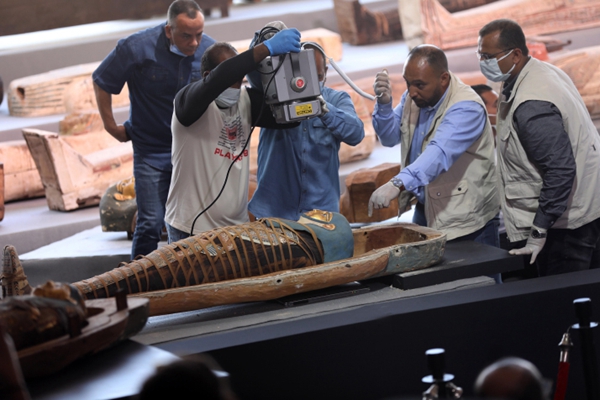Egypt's latest important archaeological discovery will benefit tourism sector
- By Muhammad Mansour
 0 Comment(s)
0 Comment(s) Print
Print E-mail ChinAfrica, February 1, 2021
E-mail ChinAfrica, February 1, 2021

Egypt's antiquities officials announced the discovery of almost 100 delicately painted wooden coffins, some containing mummies, and around 40 gilded statues dating back 2,500 years, in the necropolis of Saqqara, south of Cairo.
The new find, announced in November last year, followed hot on the heels of a previous find of 59 ancient coffins.
The latest discovery, considered the largest of 2020, comes at a time when the country's tourism sector is crippled by the COVID-19 pandemic that deterred foreign tourists from visiting the country's archaeological sites, and, in turn, impacted the broader Egyptian economy.
Major tourist attraction
The Oxford Business Group (OBG), a global publishing, research and consultancy firm, estimated that tourism contributed to more than 9 percent of Egypt's GDP in 2019. Meanwhile, the International Monetary Fund has downgraded its forecast for tourism expenditure in Egypt from $17.8 billion to $2.7 billion.
The crisis group within the Egyptian Government not only had to shift the focus from international to domestic tourism to make up for losses caused by the pandemic, but it also looked beyond the crisis in an attempt to put Egypt back on the world travel map.
In this sense, the government is luring international media and diplomats to the front line of discoveries in the hope that such wide-ranging media coverage would improve the image of Egypt overseas and, therefore attract targeted tourists to visit the country.
More discoveries are underway at the site, with archaeologists expecting to discover an ancient workshop that prepared bodies for mummification within the next few months. The find will both enrich Egyptian archaeological landmarks and be a major drawcard for Egyptology-interested tourists to visit the country.
The necropolis of Saqqara holds more than a dozen burial sites, including the 4,700-year-old Step Pyramid of King Djoser, a magnificent six-story building and the first known burial pyramid in the world. The building, where the latest discoveries were found, was reopened after a 14-year, $6.6-million restoration.
Saqqara, stretching some 6.2 km across the Western Plateau, was designated as a World Heritage Site by UNESCO in 1979.
Egypt's Tourism and Antiquities Minister Khaled el-Anany said the discovered items date back 2,500 years to the Ptolemaic Dynasty that ruled Egypt for some 300 years, "The new finds are just the beginning of a series of [other] discoveries that will be unearthed in the next few years," said el-Anany.
El-Anany said the government would move the newly discovered artifacts to three museums in Cairo, including the Grand Egyptian Museum that Egypt is building near the famed Giza Pyramids. In April 2020, the planned opening of the museum was postponed to 2021 due to the pandemic.
El-Anany said this was the largest archaeological discovery in 2020. At the announcement of the discovery, he told the media and 43 attending foreign ambassadors and diplomats that the momentous find needed to be shared with the rest of the world.
"This discovery is very important because it proves that Saqqara was the main burial [site] of the 26th Dynasty [mid-600s B.C. to 525 B.C]," said former minister of Antiquities Zahi Hawass, adding that it would also enrich pre-existing knowledge about the art of mummification in that period.
Archaeological marvels
The government expected the tourism sector to grow in 2020 - then the pandemic broke out, leading to the suspension of international flights last March and in turn the closure of the country's archaeological sites and museums. And while domestic tourism continued, especially in the country's resorts overlooking the Red Sea and the Mediterranean, the pandemic dealt a blow to the sector by causing a further decrease in the number of foreign tourists, who are more attracted to cultural sites.
Unlike its neighboring countries that imposed curfews and suspension of flights at the peak of the pandemic, Egypt's tourism authorities were swimming against the tide by opening the door for foreign tourists and providing incentives and safety guarantees.
Last July, some attractions reopened after a brief closure, including the Great Pyramids of Giza, as well as hotels, all operating within the COVID-19 safety protocols set by the World Health Organization.
Last September, more archaeological sites reopened and the Egyptian Government announced further measures to support the sector, including extending visa fee exemptions for tourism hubs in Luxor, Aswan, the Red Sea and South Sinai until April 2021, and delaying repayments on utility bills and debts for tourism-related companies.
"The Ministry of Tourism and Antiquities has been exerting monumental efforts in the last few years to enhance and shed light on Egypt's archaeological treasures," said Amr Karim, General Manager for Travco Travel, one of Egypt's largest travel operators.
Karim said some of the efforts included the relocation of 22 royal mummies from the Egyptian Museum in Tahrir Square to their new home at the National Museum of Egyptian Civilization.
As part of the government's efforts to enhance the tourism sector, it invested more than $1 billion to construct the Grand Egyptian Museum, covering an area of 1 million square meters, and located close to the Pyramids of Giza. The museum is due to open this year.
Described as one of the largest archaeological museums in the world, the Grand Egyptian Museum will house priceless artifacts of ancient Egypt, including the complete Tutankhamun collection of more than 5,000 artifacts from King Tutankhamun's burial chamber - many of which will be displayed for the first time.
Egypt's efforts to overcome challenges facing its tourism sector is moving in the right direction and likely to yield promising results this year and beyond.






Go to Forum >>0 Comment(s)